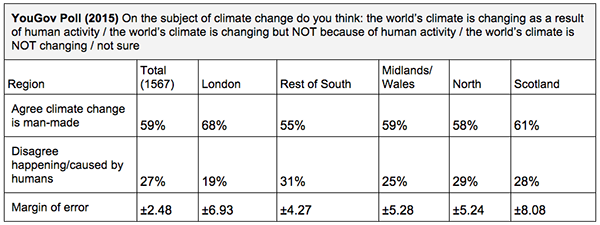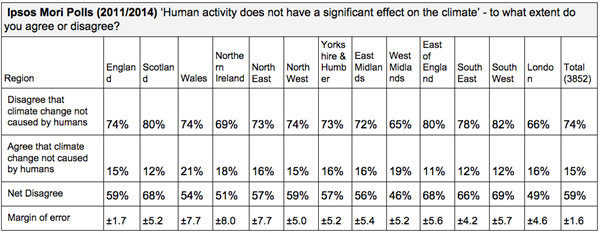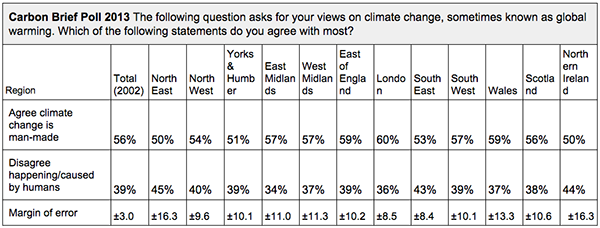Analysis: Regional attitudes to climate change across the UK
Rosamund Pearce
05.22.15Rosamund Pearce
22.05.2015 | 11:00amDo people across Britain think differently about climate change? Or does the UK speak as one voice? Data on regional attitudes to climate change is pretty thin on the ground, but the information that exists from the UK and further afield seems to tell an intriguing story.
A study published earlier this year in Nature Climate Change found differences in Americans’ views on climate change, depending on where they lived.
Based on survey data gathered between 2008 and 2014, people living in the central US tended to be less worried about global warming than the national average, while residents of drought-stricken California showed noticeably more concern.
The map below shows the study’s results . Red indicates high concern, blue is lower concern.
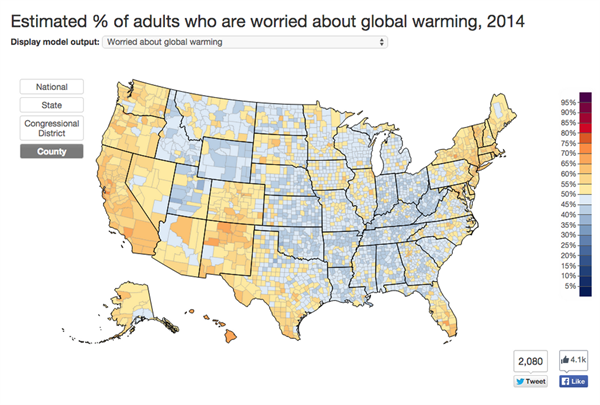
How attitudes to climate change vary across the US. Source: Howe et al. (2015).
UK opinion on causes of climate change
Crossing the Atlantic to the UK, YouGov recently carried out a poll for the Sunday Times, showing how public perception of climate change varies across five regions: London, the South, Wales and the Midlands, the North and Scotland.
Participants were asked which of the following statements they agreed with: the climate is changing as a result of human activity, it’s changing but not because of human activity, it’s not changing, or they’re unsure.
Subtracting the number of people who disagree that climate change is human caused from the number who agree is one way to express an overall level of agreement. We’ve plotted this in the map below:
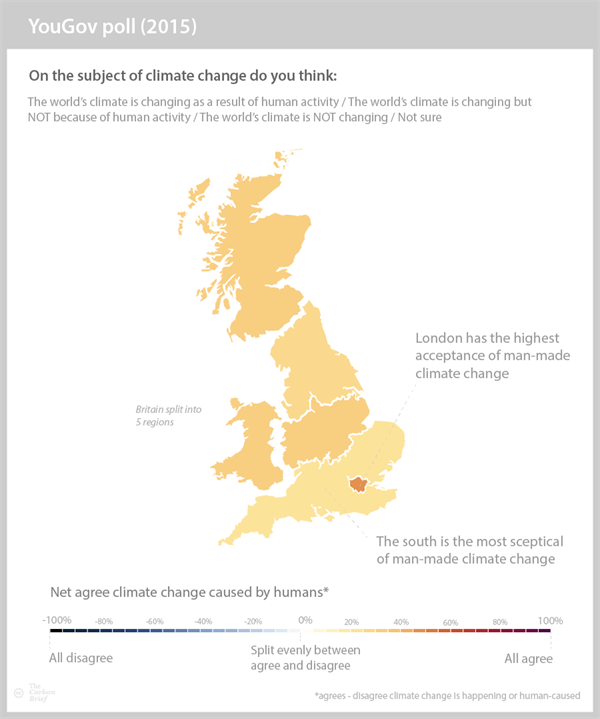
Source: YouGov/The Sunday Times. Map by Rosamund Pearce for Carbon Brief.
On balance, it seems Britons are not so different from each other.
Looking at the map above, all five regions are within the orange-yellow band of the colour scale, suggesting that many more respondents agreed human activity is causing climate change than disagreed, or thought it wasn’t happening at all.
Region by region
There is some variation from region to region, however. Geographical variations can happen because of differences in demographics, cultural and ideological factors, and because people with similar characteristics “tend to cluster together”, according to the authors of the US study. Previous studies have suggested that local weather can also affect climate change perceptions, the scientists note.
The table below shows the results of the YouGov poll region-by-region:
Notably, Londoners appear to have a much higher acceptance of man-made climate change than the rest of the UK. In the capital, 68% of people agreed climate change is human-caused, compared to a national average of 59%.
Polls providing greater geographic detail than the five regions in the YouGov poll are pretty few and far between. While there have been plenty of surveys to see what Britons think about global warming, specific information about the location of respondents is often lacking or unavailable for privacy reasons. There is also the difficulty that the more you zoom in regionally, the larger the overall sample size has to be to produce reliable data.
The Public Attitudes to Science survey, carried out by Ipsos Mori on behalf of the UK government, provides the biggest regional breakdown within the various polling archives we could find, splitting the country into 12 government administrative regions.
Pooling together from the 2014 and 2011 surveys – previous ones did not ask exactly the same questions – gives a sample size of around 4,000 people nationally. Ideally, data would come from the same survey as regional patterns can change over time. But to obtain a large enough sample size, data can be combined across more than one survey, says polling expert Leo Barasi, if the questions are the same.
Participants were asked to what extent they agreed or disagreed with the statement: ‘Human activity does not have a significant effect on the climate’.
The findings were interesting – and seem to show some differences with the recent YouGov poll. We’ve shown the results in the table below, split up by region:
At a country level, Scotland appears to be the least sceptical of man-made climate change, with only 12% of people saying they agree human activity does not have a significant effect on the climate. This is followed by England (15%), Northern Ireland (18%) and Wales (21%) (but note also the margins of error).
Noticeably, the results showed something of a North-South divide in England – with the Midlands and the North more sceptical than the South.
Respondents in the South-West were the least sceptical of all the government regions with 82% of people disagreeing with the statement that humans don’t cause climate change.
This could be partly a result of the region experiencing severe flooding, says Barasi. A recent study suggests the 2013/2014 floods in the UK pushed up public acceptance of human-caused climate change, particularly among those personally affected.
Parallels could, perhaps, be drawn with the US study, too. California and Massachusetts were among the most concerned about climate change in the Yale study, and both have recently experienced record-breaking weather. More research is needed to clarify a possible link, however.
The Ipsos Mori results places London among the more sceptical regions in the UK, with 16% of respondents disagreeing that climate change is human-caused. This pattern is markedly different to the YouGov poll, where Londoners showed the highest acceptance of man-made climate change of all UK regions. However, it is difficult to compare the data directly as the questions are worded so differently.
A question of weighting
As ever, any single poll should be treated with caution until it’s clear the results are backed up elsewhere (and, as the general election has shown, even multiple polls can get it wrong). Barasi says he’s surprised by what the Ipsos Mori surveys seem to show about regional differences. He tells Carbon Brief:
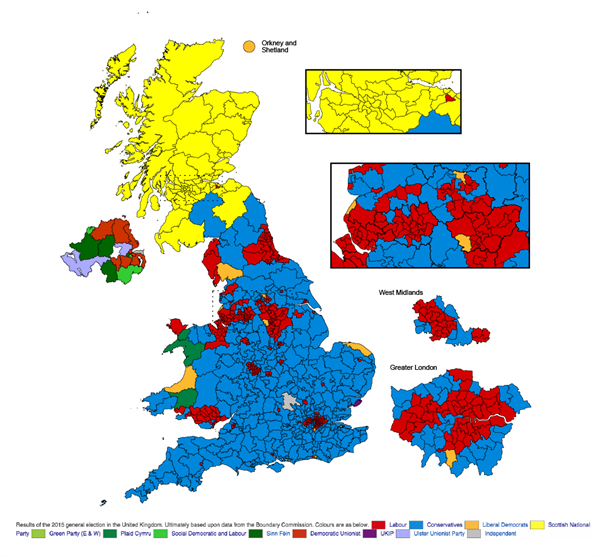
The UK General Election results in 2015. Source: Wikipedia.
Indeed, a similar nationwide poll of public perceptions of climate change that Carbon Brief conducted in 2013, again, shows some different results to the Ipsos Mori poll.
With a smaller sample size of 2,000, the Carbon Brief poll showed London to be the most accepting of climate change, with 60% agreeing that it is happening and is mostly caused by humans. The South East was among the least accepting, with 53% in agreement.
In a similar vein, an Observer poll published earlier this month found that people from London were most likely to agree that increasing frequency of extreme weather was a sign of climate change, while those living in the North West were least likely to agree.
Why the difference between the Ipsos Mori poll and the others?
One explanation could lie in sampling errors. Anna Quigley, director of the Ipsos Mori poll, tells Carbon Brief:
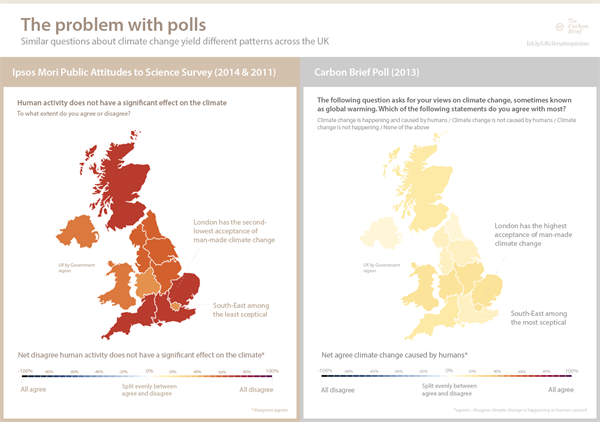
Source: Ipsos Mori Public Attitudes to Science Survey (2011 and 2014) and Carbon Brief. Graph by Rosamund Pearce for Carbon Brief.
How polling data is analysed could prove to be even more of a problem, says Barasi. The Ipsos Mori data has been weighted – a technique used by many polls to give some data more influence than others – to ensure the results are representative of the national demographic.
But according to Barasi, this could potentially skew the sample profiles within each region, making the results an artifact of the weighting process rather than offering real insight.
In the Ipsos Mori poll, Barasi says 18-24 year olds appear over-represented in the South-East, for example, which could be significant as climate change perception varies across age and gender.
Quigley agrees, saying that skewed results from weighting are the “most likely explanation for the 2011 data and may be part of the issue for the 2014 data”.
A detailed view
Public opinion on climate change is complex, and measuring it is even more so. Regional polling reveals a nuanced view of public opinion that can be hidden if you look only at the national average. And with so little data about how and why opinion varies from region to region, a comprehensive understanding will continue to elude us, suggests an editorial in the latest edition of Nature Climate Change. Referring to the last month’s Yale study, it says:
So, while national surveys can give us some important information about public perception of climate change, they only form part of the story. While there may not be a wealth of regional data available yet, it’s intriguing to see patterns emerging.



